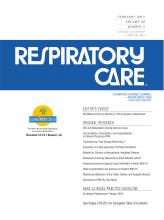To the Editor:
In the July 2012 issue of the Journal, Borg and Thompson1 reported the effect of 2 different vital capacity methods on lung volume data and patient classification derived from whole body plethysmography. The preferred method according to American Thoracic Society/European Respiratory Society recommendations is to follow closed-shutter panting with exhalation to residual volume (RV, expiratory reserve maneuver) followed by inhalation to total lung capacity (TLC).2 The alternative method is to follow closed-shutter panting with inhalation to TLC from functional residual capacity (FRC), followed by exhalation to RV. As the authors point out, the reasoning behind the preferred method is that RV could be elevated in patients with air-flow obstruction if the alternative method is utilized. Interestingly, Borg and Thompson did not observe this phenomenon, but found that in some patients without air-flow obstruction the alternative method produced smaller TLC values, due to reduced inspiratory capacity. The reason for different inspiratory capacity measurements in a minority of patients using the alternative method is unclear. As the authors suggest, perhaps patient coordination, respiratory muscle length-tension characteristics, or voluntary ventilatory control from the 2 starting points are responsible for the different outcome.
This is a phenomenon that I have also observed during spirometry testing. During spirometry testing the American Thoracic Society/European Respiratory Society guidelines recommend that patients inhale to TLC from FRC (similar to the alternative method), then exhale forcefully to RV.3 Making sure that the patient is truly inhaling to TLC prior to forced exhalation is critical during spirometry testing. Suboptimal inhalation may be the most difficult error to detect during spirometry testing, and requires inspection of the inspiratory flow-volume loop. Suboptimal inhalation can occur in some patients due to inadequate effort or a premature command to exhale; however, this is usually intermittent and can be corrected by instructions and encouragement to inhale deeper. However, in some patients the inspired volume following forced exhalation (ie, inspiratory loop) consistently and substantially exceeds the inspired volume recorded prior to forced exhalation, despite re-instruction and outward signs of good patient effort. My approach to these patients has been to plan on capturing the FVC after the second deep inhalation.
Figures 1 and 2 depict an example of a patient who consistently inhaled to a higher TLC from RV than from FRC during spirometry, and whole body plethysmography testing, respectively. The alternative method is used in Figure 2; however, the suboptimal inhalation from FRC is corrected by a second inhalation from RV. In other words, the alternative method was followed by the preferred method. This patient repeated this pattern on every lung volume and spirometry measurement.
Volume/time graph and flow/volume loops from a patient who consistently acheived a higher end-inspiratory volume from residual volume than from functional residual capacity. Arrows indicate the second deep inhalation used to measure forced spirometry.
Whole-body plethysmographic lung volume graphic from a patient who consistently acheived a higher end-inspiratory volume from residual volume than from functional residual capacity (FRC). VTG = thoracic gas volume. SVC = slow vital capacity.
I am unable to report the frequency of this phenomenon; however, I have observed it enough to save the screen shots used to create Figures 1 and 2 for teaching purposes, and to nickname these types of patients as “two-timers.” The data presented by Borg and Thompson suggest that this occurrence may represent a true phenomenon among pulmonary function testing subjects that is unrelated to patient effort; if so, the expiratory reserve maneuver may be the preferred method not only for lung volume testing but also spirometry testing in some patients.
Footnotes
The author has disclosed no conflicts of interest.
- Copyright © 2013 by Daedalus Enterprises
REFERENCES
The Authors Respond:
Haynes raises an interesting point regarding the performance of spirometry based on the findings of our static lung volume study.1 For the majority of subjects, the expiratory and inspiratory volumes measured during a forced spirometry maneuver match, resulting in a closed flow-volume loop. Haynes observes that the volume of the complete inspiratory breath performed after a maximal forced expiration exceeds the volume of the forced expiratory maneuver preceding it. This observation suggests that the maximal expiratory maneuver has, in fact, not been performed from a position of maximal inhalation and, as a consequence, FEV1 and FVC values may be underestimated.
We are unable to offer alternative explanations to those proposed by Haynes for this occurrence, and agree that subject coordination or performance issues resulting in this pattern can be improved with feedback and re-instruction from the operator. Differences in mechanical advantage for a maximal inhalation from FRC, compared to RV, may be more difficult to overcome. Equipment issues, particularly differences in correction factors for inspiratory and expiratory volumes, may play a role in loop closure issues, though in the case cited by Haynes this is unlikely, as the subject was able to achieve a closed loop with a second expiratory effort.
An alternative management strategy for subjects presenting with this pattern who are unable to close the loop with feedback and re-instruction, may be to ask them to exhale gently to RV from FRC after a couple of tidal breaths. Once at RV, to then take a maximal forced inspiratory vital capacity breath to TLC and finish the effort with a forced expiratory maneuver.
Further study into the frequency of and mechanisms resulting in this phenomenon is warranted. Test operators, in the meantime, should coach subjects to achieve maximal expiratory and inspiratory efforts and inspect for loop closure. When greater volumes are detected on maximal inspiration following maximal expiration, alternative methodologies should be used to maximize expiratory results and limit the possibility of underestimating FEV1 and FVC.
Footnotes
The authors have disclosed no conflicts of interest.
REFERENCE
- 1.↵













